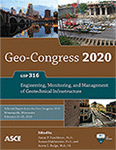Geo-Congress 2020
Limit Equilibrium Analysis of Geosynthetic-Reinforced Retaining Walls Subjected to Footing Loading
Publication: Geo-Congress 2020: Engineering, Monitoring, and Management of Geotechnical Infrastructure (GSP 316)
ABSTRACT
Geosynthetic-reinforced retaining (GRR) walls have been utilized as bridge abutments to support shallow foundations of bridges instead of traditional deep foundations, such as piles. In this technology, GRR walls support both bridge beams on spread footings constructed directly on the reinforced soil mass and approaching roadway embankments. However, limited studies have been carried out to investigate potential slip surfaces and their corresponding factors of safety when the wall is subjected to footing loads. The focus of this study is to investigate the effect of the footing loading on global stability of GRR walls with modular block facing. The limit equilibrium (i.e., the Bishop simplified method) in the ReSSA program was used to determine the potential slip surfaces and their corresponding factors of safety. Parametric studies were carried out by varying two parameters, i.e., the width and the offset distance of the footing from the wall facing, to investigate their effects on the potential slip surface and the factor of safety. The results show that the slip surfaces began from the far edge of the footing and developed into the reinforced zone towards the wall facing. When the width of the footing was increased, under the same applied load, the factor of safety slightly increased. However, the offset distance of the footing from the wall facing had a minor effect on the factor of safety.
Get full access to this article
View all available purchase options and get full access to this chapter.
REFERENCES
Abu-Hejleh, N., Zornberg, J. G., Wang, T., & McMullen, M. (2001). Performance of geosynthetic-reinforced walls supporting the Founders/Meadows Bridge and approaching roadway structures. Report 2: Assessment of the performance and design of the front GRS walls and recommendations for future GRS abutments.
ADAMA Engineering, Inc, (2008). ReSSA Software Version 3.0 Newark, Delaware, USA.
Adams, M., and Nicks, J. (2018). "Design and construction guidelines for geosynthetic reinforced soil abutments and integrated bridge systems." United States. Federal Highway Administration.
Adams, M., Nicks, J., Stabile, T., Wu, J. T., Schlatter, W., and Hartmann, J. (2011). "Geosynthetic reinforced soil integrated bridge system, synthesis report." United States. Federal Highway Administration.
Ahmadi, H. and Bezuijen, A. (2018). “Full-scale mechanically stabilized earth (MSE) walls under strip footing load.” Geotextiles and Geomembranes, 46(3), pp.297-311.
Berg, R., Christopher, B., Samtani, N. (2009). Design and construction of mechanically stabilized earth walls and reinforced soil slopes, vols. 1 & 2. Report No: FHWA-NHI-10–024. FHWA, U.S. Department of Transportation.
Bishop, A.W. (1955). “The use of the slip circle in the stability analysis of slopes.” Geotechnique 5, 7–17.
Han, J., 2015. Principles and practice of ground improvement. John Wiley & Sons.
Han, J. and Leshchinsky, D. (2010). “Analysis of back-to-back mechanically stabilized earth walls.” Geotextiles and Geomembranes, 28(3), pp.262-267.
Helwany, S.M., Wu, J.T. and Froessl, B. (2003). “GRS bridge abutments—an effective means to alleviate bridge approach settlement.” Geotextiles and Geomembranes, 21(3), pp.177-196.
Jiang, Y., Han, J., Parsons, R.L. and Brennan, J.J. (2016). “Field instrumentation and evaluation of modular-block MSE walls with secondary geogrid layers.” Journal of Geotechnical and Geoenvironmental Engineering, 142(12), p.05016002.
Kakrasul, J.I., Han, J., Rahmaninezhad, S.M. and Weldu, M. (2016). “Model tests of geosynthetic-reinforced earth walls with limited-space retained fill.” Vol. 2 of Proc., 3rd Pan-American Conf. on Geosynthetics (GeoAmericas)(pp. 1279-1286).
Lee, K.Z., Wu, J.T. (2004). “A synthesis of case histories on GRS bridge-supporting structures with flexible facing.) Geotextiles and Geomembranes 22(4), 181-204.
Rahmaninezhad, S.M., 2019. Geosynthetic Reinforced Retaining Walls with Flexible Facing under Footing Loading (Doctoral dissertation, University of Kansas).
Rahmaninezhad, S.M., Han, J., Kakrasul, J.I., and Weldu, M. (2018). “Stress Distributions and Pullout Responses of Extensible and Inextensible Reinforcement in Soil Using Different Normal Loading Methods.” Geotechnical Testing Journal, 42(6).
Skinner, G.D., Rowe, R.K. (2005). “Design and behaviour of a geosynthetic reinforced retaining wall and bridge abutment on a yielding foundation.” Geotextiles and Geomembranes, 23(3), 234-260.
Tatsuoka, F., Tateyama, M., Koseki, J., Yonezawa, T. (2014). “Geosynthetic-reinforced soil structures for railways in japan.” Transportation Infrastructure Geotechnology, 1(1), 3-53.
Yang, G., Liu, H., Lv, P., Zhang, B. (2012). “Geogrid-reinforced lime-treated cohesive soil retaining wall: Case study and implications.” Geotextiles and Geomembranes 35, 112-118.
Xiao, C., Han, J. and Zhang, Z. (2016). “Experimental study on performance of geosynthetic-reinforced soil model walls on rigid foundations subjected to static footing loading.” Geotextiles and Geomembranes, 44(1), pp.81-94.
Xie, Y. and Leshchinsky, B. (2015). “MSE walls as bridge abutments: Optimal reinforcement density.” Geotextiles and Geomembranes, 43(2), pp.128-138.
Xie, Y., Leshchinsky, B. and Han, J. (2019). “Evaluation of Bearing Capacity on Geosynthetic-Reinforced Soil Structures Considering Multiple Failure Mechanisms.” Journal of Geotechnical and Geoenvironmental Engineering, 145(9), p.04019040.
Zhu, H., Ma, Y., Liu, Y.X., Wang, J. (2008). “Application of the geogrid reinforced soil retaining walls for a high slope supporting project.” Geosynthetics in Civil and Environmental Engineering,266-270.
Information & Authors
Information
Published In
Geo-Congress 2020: Engineering, Monitoring, and Management of Geotechnical Infrastructure (GSP 316)
Pages: 464 - 471
Editors: James P. Hambleton, Ph.D., Northwestern University, Roman Makhnenko, Ph.D., University of Illinois at Urbana-Champaign, and Aaron S. Budge, Ph.D., Minnesota State University, Mankato
ISBN (Online): 978-0-7844-8279-7
Copyright
© 2020 American Society of Civil Engineers.
History
Published online: Feb 21, 2020
Published in print: Feb 21, 2020
ASCE Technical Topics:
- Analysis (by type)
- Business management
- Design (by type)
- Engineering fundamentals
- Engineering mechanics
- Equilibrium
- Footings
- Foundations
- Geomaterials
- Geosynthetics
- Geotechnical engineering
- Limit analysis
- Limit equilibrium
- Load factors
- Practice and Profession
- Public administration
- Public health and safety
- Retaining structures
- Safety
- Shallow foundations
- Statics (mechanics)
- Structural design
- Structural engineering
- Structural members
- Structural systems
- Walls
Authors
Metrics & Citations
Metrics
Citations
Download citation
If you have the appropriate software installed, you can download article citation data to the citation manager of your choice. Simply select your manager software from the list below and click Download.
